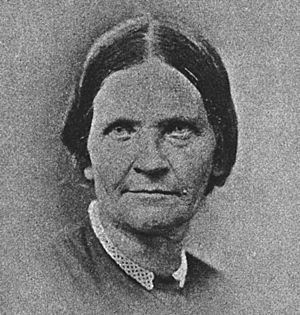Amalie Dietrich facts for kids
Koncordie Amalie Dietrich (born Nelle) (1821–1891) was a German naturalist. A naturalist is someone who studies nature, like plants and animals. She is best known for her work in Australia from 1863 to 1872. During this time, she collected many different natural items for the Museum Godeffroy in Hamburg, Germany.
It's important to know that Amalie Dietrich also collected human remains of Indigenous Australians. She sent these to Hamburg for museums. This practice was sadly common in her time for scientific study. However, today, collecting human remains in this way is seen as very disrespectful and wrong. Because of this, some people in Australia called her the 'Angel of Black Death'. Her work, both with plants and human remains, is still discussed today. People talk about how it connects to the history of colonialism.
Amalie Dietrich's Career
Amalie Dietrich was born in Siebenlehn, a town in Saxony, which was part of the German Confederation at the time. In 1846, she married Wilhelm August Salomo Dietrich, who was a doctor. She learned a lot from him about how to collect natural specimens. A specimen is a sample of something, like a plant or animal, kept for study. They both planned to work as naturalists.
Between 1845 and 1862, Amalie and Wilhelm earned money by collecting plants and animals from the Alps mountains. They sold these to chemists for medicines and to museums for their collections. Some of the delicate mountain flowers she collected are still on display in the Natural History Museum in Freiburg, Germany.
Over time, Wilhelm spent more time preparing the specimens. Amalie did most of the collecting. This meant she had to spend long periods away from home. This was especially hard after her daughter, Charitas, was born in 1848. In 1861, she decided to separate from her husband.
Naming New Species
Amalie Dietrich collected many "type specimens." A type specimen is the original example of a species that scientists use to describe and name it. Because of her important work, many new species were named in her honor. Their scientific names include parts like dietrichiae, dietrichiana, or amaliae.
Here are a few examples of species whose type specimens she collected:
- Aongstroemia dietrichiae (a type of moss)
- Sargassum amaliae (a type of seaweed)
- Acacia dietrichiana (a type of wattle tree)
- Persoonia amaliae (a type of plant)
- Nortonia amaliae (a type of wasp)
- Drosera dietrichiana (a type of sundew plant)
Her collections were very important for a book called Zur Flora von Queensland (meaning "On Queensland's Flora"), written in 1875 by Christian Luerssen. She also visited another famous botanist, Ferdinand von Mueller, in Australia. Today, the National Herbarium of Victoria in Australia holds 2,790 of her collected specimens.
Even though she didn't publish any scientific papers herself, her collections are still a valuable resource. They are kept in many important plant and natural history museums around the world. These include museums in Berlin, London, Paris, and Washington D.C.
A place in Australia, Dietrich Place in the Canberra suburb of Chisholm, is named after her. This honors her work in Australia.
See also
 In Spanish: Amalie Dietrich para niños
In Spanish: Amalie Dietrich para niños


